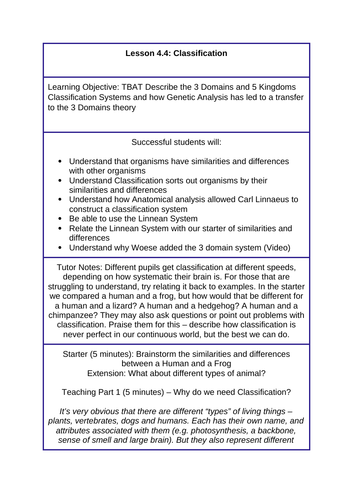

Enhance your understanding of classification systems with this comprehensive teaching resource designed for GCSE Edexcel Combined Science and GCSE Edexcel Biology students. In Lesson 4.4, you will delve into the intriguing world of taxonomy and learn about the 3 Domains and 5 Kingdoms Classification Systems. Explore how Genetic Analysis has transformed our understanding of classification. By the end of this lesson, you’ll grasp the significance of classification, its historical development, and the modern genetic insights that have reshaped it.
Learning Objective:
By the end of this lesson, students will be able to describe the 3 Domains and 5 Kingdoms Classification Systems, and understand the role of Genetic Analysis in evolving the 3 Domains theory.
Key Takeaways for Successful Students:
Recognize the similarities and differences among organisms.
Comprehend the purpose of classification in organizing organisms.
Trace the origins of classification to Carl Linnaeus’ anatomical analysis.
Apply the Linnean System for classification.
Connect the Linnean System to the concept of similarities and differences.
Explore the rationale behind the addition of the 3 domain system.
Appreciate that classification is a dynamic process in an ever-changing world.
Lesson Structure:
Starter (5 minutes): Engage students in a brainstorming session, comparing the similarities and differences between a human and a frog. Encourage them to consider other animal comparisons for extension.
Teaching Part 1 (5 minutes): Why do we need Classification?
Highlight the significance of classification for the study of organisms.
Emphasize how classification mitigates language barriers and confusion in naming organisms.
Teaching Part 2 (10 minutes): Linnaean Classification
Explore the history of classification, with focus on Carl Linnaeus.
Explain the Linnaean hierarchical system (Kingdom, Phylum, Class, Order, Family, Genus, Species).
Illustrate the increasing specificity of classification levels.
Activity 1 (5 minutes): Students research the classification of organisms they’ve interacted with and present their binomial names in the correct format.
Activity 2 (15 minutes): Card Exercise: Guide students in sorting names into appropriate classification levels, fostering hands-on understanding.
Teaching Part 3 (8 Minutes): Watch an engaging educational video on the domains of life to reinforce the concept visually.
Summary Activity (10 Minutes): Classification Quiz
Evaluate students’ comprehension with a quiz that covers the main concepts of the lesson.
Student Evaluation: Facilitate a self-assessment session where students reflect on their learning experience, identify areas for improvement, and express what intrigued them the most.
Something went wrong, please try again later.
This resource hasn't been reviewed yet
To ensure quality for our reviews, only customers who have purchased this resource can review it
Report this resourceto let us know if it violates our terms and conditions.
Our customer service team will review your report and will be in touch.
